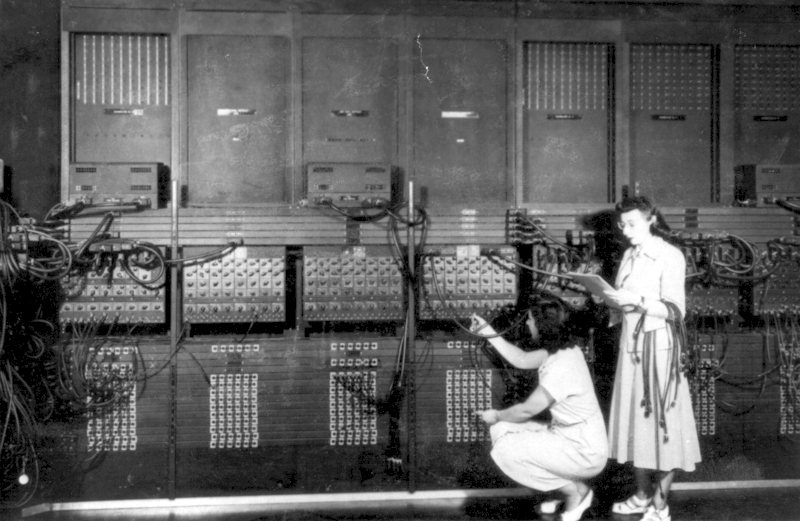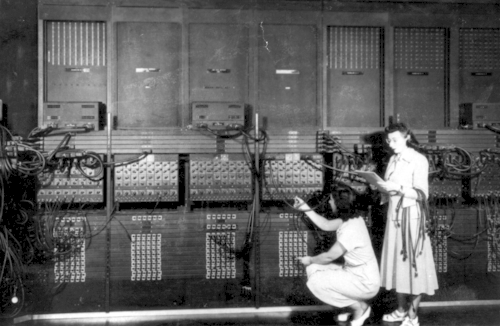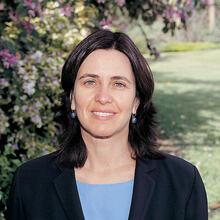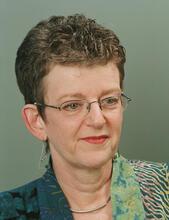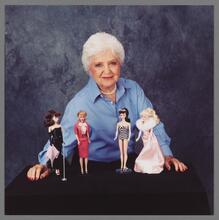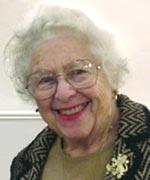Jewish Women in Computer Science
Jewish women have participated in some of the pioneering computer science projects in the United States. As the computer developed from a calculating machine into a tool for business, communication, and data processing, Jewish women were among those on the front lines of shaping new innovations in computing–and in doing the less celebrated, but equally important, manual labor to make machines run. From the early association of women with computing jobs through the subsequent systematic underrepresentation of women in software engineering, Jewish women have designed new programming languages, developed theoretical contributions to computer science, and been recognized for their substantial contributions to the field.
Before a “computer” was a machine, it was a job title. Human computers performed the computations that produced mathematical tables, astronomical positions, and other calculation-based results for their employers. Computing jobs were considered clerical positions that required little training or skill and were thus deemed not only acceptable but particularly suited for women. At the Harvard College Observatory in the 1890s, for example, women computers were tasked with mapping, classifying, and cataloguing stars; at NASA’s precursor, NACA, women computers’ jobs included processing test data and calculating orbital trajectories.
As businesses and innovators sought to shift computing tasks from humans to electronic digital calculators over the course of the twentieth century, operating the computing machines frequently remained women’s work. Women in early computing performed manual and mathematical labor — programming, debugging, assembling, and designing — that not only supported but also helped shape the development of computer science. Their contributions are increasingly being written back into histories of computing, which have previously focused on “great men” and their machines.
A number of Jewish women have been part of significant projects on the cutting edge of twentieth-century computer science. The following women represent a cross-section of some of the computing work done in the United States during that time period, and the varied roles that Jewish women have played in bringing these projects to fruition. With rare exceptions, these women’s Jewish identities have remained firmly demarcated from their professional lives, and remain largely unaddressed in the archival records they left behind.
The Jewish Women of ENIAC
As men were sent to the front during World War II, more employment opportunities opened up for women on the United States’ home front. Women with degrees in mathematics were especially sought for military-related computational jobs in both industry and the government. In keeping with the gendered divisions of labor of the time, such computational work was considered an appropriately feminine way for women to perform their patriotic duties.
Jews made up only about 3% of the US population at the time, but — despite universities’ discriminatory admissions practices, which limited the number of Jewish students — they had a significantly higher rate of representation on college campuses. For this reason, many Jewish women were well-positioned to take up the new computing jobs that prioritized hiring holders of bachelor’s degree. In 1943, Ruth Lichterman (later Teitelbaum; 1924-1986) and Marlyn Wescoff (later Meltzer; 1922-2008,) were two of approximately 200 women employed by the US Army’s Ballistic Research Laboratory (BRL) to calculate firing tables for rockets and artillery shells. Both had recently graduated from college (Lichterman with a degree in mathematics, Wescoff in social studies), and were recruited from their posts at the BRL to operate a new computing machine called ENIAC (Electronic Numerical Integrator and Computer).
Conceived in 1943, ENIAC was designed to mechanize the same ballistic calculations that had previously been performed by the BRL’s human computers. The project was funded by the military and designed by engineers at the University of Pennsylvania’s Moore School of Electrical Engineering under the direction of J. Presper Eckert, Jr., and John Mauchly. ENIAC was a massive machine, comprised of 48-foot-tall panels and approximately 18,000 vacuum tubes. While ENIAC was not the first operational electronic digital computer, as it is often described, it did hold the distinction of being the only functioning fully electronic computer in the United States until 1950. Before it was decommissioned in 1955, ENIAC was used to calculate primes, sines, and cosines; numerically model weather, ballistic trajectories, and explosions; and run computations at speeds that far surpassed the capabilities of human computers. However, World War II ended before ENIAC could produce the ballistic tables for which it was designed.
In the early days of ENIAC, the team of ENIAC operators of which Lichterman and Wescoff were a part was comprised of six women from across the BRL, working under John Holberton. All six had traveled from Philadelphia to the BRL’s punched-card facility in Aberdeen, Maryland, for six weeks of training that would familiarize them with ENIAC’s card punch and card reader equipment. The team’s subsequent work on ENIAC was physical as well as mathematical: they applied their knowledge of the machine’s wiring, logic, and structure to not only manually program ENIAC by wiring inputs to outputs on its plugboards, but also to diagnose troubles from burnt-out vacuum tubes to faulty wiring.
Like many other wartime projects in computing, ENIAC was classified as “confidential,” though historians have referred to it as an “open secret” within the landscape of wartime scientific and technological military projects. The machine made its public debut in February of 1946 with demonstrations for both journalists and 110 other guests of military and scientific distinction. ENIAC’s operators worked laboriously to program the calculations for the public demonstrations. The media was impressed by the mere fifteen seconds that it took the machine to perform the calculation, but press reports ignored the women operator’s work entirely, instead giving sole credit to the project’s engineers and officers.
Adele Goldstine, Klara von Neumann, and ENIAC’s Monte Carlo Simulation Program
Another key ENIAC contributor omitted from the 1946 press reports was senior computer Adele Goldstine (née Katz, 1920-1964). The only woman working on ENIAC’s hardware at the time, Goldstine held a master’s degree from the University of Michigan, the highest mathematical credential of any woman working with ENIAC. She ran the WAC (Women’s Army Corps) course at the Moore School and, along with Mildred Kramer (née Tokarsky) and Mary Mauchly, instructed the WAC women in the mathematics for ballistics calculations. Her husband, Herman Goldstine, was concurrently employed by the U.S. Army as the BRL liaison for the ENIAC project.
The extent of Adele Goldstine’s role in programming ENIAC and training its operators has been contested both in patent proceedings and by historians, but her contributions to ENIAC’s documentation are indisputable. Adele Goldstine was the sole credited author of a two-volume explanation of ENIAC’s configuration. She also collaborated with Moore School professor Harry Huskey to write an ENIAC operating manual, technical report, and maintenance manual, and contributed to a 1947 paper called “Planning and Coding Problems for an Electronic Computing Instrument.” That same year, at age 26, she was hired by Los Alamos as a consultant for ENIAC’s new project in atomic fission simulation (also called “Monte Carlo simulation,” for its use of statistical calculations in the Monte Carlo method). The conversion plan and instruction set that she wrote for ENIAC’s transition into a new “stored program” mode was complete by that July. She subsequently wrote code for another type of atomic simulation to be run on ENIAC, called Hippo, before leaving to work with IBM in 1948.
By the end of 1948, ENIAC itself had been successfully moved to Aberdeen, Maryland, and reconfigured to operate in its new mode for the Monte Carlo simulations. Some historians point to ENIAC’s 1948 atomic fission simulation as “the first modern computer code” to be executed, marking a significant milestone in the history of computing.
Meanwhile, Los Alamos had hired another Jewish woman, Klara von Neumann (née Dan, 1911-1963), as a consultant for the Monte Carlo simulation project. Her husband, renowned mathematician John von Neumann, had introduced her to the ENIAC project in his capacity as a leader—alongside Herman Goldstine—of the Institute for Advanced Studies’ computing project, now based in Princeton. In 1947, Klara von Neumann was new to both ENIAC and programming. Though her background in mathematics was limited to “some college algebra and some trig,” as she later wrote, she intuitively took to programming and appreciated its puzzle-like nature. She worked closely with physicist Nicholas Constantine Metropolis on the Monte Carlo simulations, diagramming and coding the simulations as well as collaborating to expand their instruction set.
Born in Budapest, Klara von Neumann was one among many other Jewish scholars and professionals who fled Europe before, during, and after World War II. She emigrated to the United States with her -new husband just before the onset of the war, a decade before her work on ENIAC.
Klara von Neumann suffered from depression and experienced a particularly difficult episode after the first run of the atomic fission calculations in 1948. The Los Alamos simulations marked her last major project in computing, as laboratories were beginning to hire full-time programming staff and short-term consultants were needed less. Her husband died in 1957; after marrying again the following year, she committed suicide in 1963.
Computing Applications
While early electronic computers were built to solve equations, later computers increasingly expanded and abstracted their capabilities. These powerful networked machines began to be used not only for processing information but also for communication, control, and commerce. During the 1950s and 60s, data storage and manipulation underpinned a wide range of new applications of electronic computers in business, government, and other activities. Jewish women participated in many such projects, widening the capabilities of electronic computers and the tasks they could perform.
Eleanor Krawitz Kolchin (d. 2019) worked as a tabulating supervisor at IBM’s Thomas J. Watson Computing Laboratory at Columbia University. A 1947 graduate of Brooklyn College, Kolchin had come to computing with a BA in Mathematics and a stint as the treasurer of Pi Mu Epsilon, an honorary mathematics society. While at Columbia, Kolchin pursued an MA in Mathematics in parallel with her work in the Watson Lab. She also instructed graduate school astronomy classes in the operation of their plugboard computers. Later, even after leaving Columbia, she supported work in astronomy and other scientific computing in Fortran. Her 1949 article describing the Watson Lab’s work has been translated into over 20 languages.
In 1965, the Library of Congress hired Henriette Avram (1919-2006) to design an automated catalog that would replace their manual card catalogs. Avram had no formal training in library science but had previously spent seven years as a programmer and systems analyst at the National Security Agency, as well as at a software firm called Datatrol. Avram developed MARC (Machine Readable Cataloging), which debuted at the Library of Congress in 1970 and was subsequently used in libraries across the world. By 1973, MARC had become the international standard, facilitating the expansion of interlibrary loan programs and making library collections more accessible to the public. At the time of her retirement from the Library of Congress in 1992, Avram was in charge of a staff of 1,700 people. She was awarded three honorary doctorates for her work.
Development of Programming Languages
Computer scientists and engineers soon developed new programming languages to support the widening range of tasks for which computers were being enlisted. A number of these projects were led, designed, and popularized by Jewish women. Their work translating instructions for the computer into written English made programming more accessible and drastically widened the number of people who could use code in their day-to-day work lives.
Jean E. Sammet (1928-2017), for example, was one member of the original committee that designed and developed Common Business Oriented Language (COBOL), an innovative programming language adopted by federal agencies and businesses alike to handle their data. Supported by the federal government and influenced by the work of computer pioneer Admiral Grace Murray Hopper, the language was an immediate and enduring success. In 2017, IBM Research reported that 200 billion lines of COBOL code were still in use by organizations across the globe.
COBOL was only the first of several programming languages that Sammet helped to design. With a BA in Mathematics from Mount Holyoke College (1948) and an MA in Mathematics from the University of Illinois at Urbana-Champaign (1949), Sammet’s career spanned multiple companies and roles. She supervised the first scientific programming group at Sperry Gyroscope (1955-1958), taught graduate courses in programming at Adelphi College (1956-1958), and managed software development at Sylvania Electric Products (1958-1961) as the company built a computer, MOBIDIC, for the Army Signal Corps. After she was hired by IBM in 1961, Sammet worked on developing FORMAC (FORmula MAnipulation Compiler), one of the first widely used programming languages for manipulating polynomials and algebraic expressions. She later founded and led SICSAM (Special Interest Committee on Symbolic and Algebraic Manipulation, later SIGSAM), which facilitated social and intellectual connections and substantially influenced the way that this subfield developed. Later, she led work on the Ada programming language in IBM’s Federal Systems Division.
Ida Rhodes (born Hadassah Itzkowitz, 1900-1986) also played a role in developing early programming languages, amidst other work in computing. Rhodes was born in Ukraine and emigrated to the United States with her parents in 1913. She received both a BA and MA in mathematics from Cornell University in 1923. Her work in computing began in earnest in 1947 when her employer, the Mathematical Tables Project—a New Deal initiative sponsored by the National Bureau of Standards—sent her to Washington, DC to learn about the NBS’s attempts to develop electronic computers. The NBS then hired Rhodes to work in their National Applied Mathematics Laboratories (NAML), which were established in July 1947.
During the early 1950s, Rhodes developed the C-10 language for the Census Bureau’s UNIVAC I, as well as the first computer program to be used by the Social Security Administration. She did especially notable work in designing processes for computer language translation. Rhodes was also a frequent lecturer: she spoke about programming and the use and potential applications of computers, and also gave computer courses specifically geared toward disabled users. She sustained a connection to her Judaism even in her computing work, publishing a paper called “Computation of the Dates of the Hebrew New Year and Passover” in Computers and Mathematics with Applications in 1977.
Barbara Liskov (née Huberman, b. 1939) was an early developer of object-oriented programming. In designing the CLU programming language, Liskov laid the foundations for object-oriented programming that would later influence popular programming languages such as Java, C++, and C#. Her most well-known contribution is the Liskov Substitution Principle, a widely used definition of subtyping, which she developed in collaboration with Jeannette Wing.
Liskov also worked in the area of distributed systems and transaction processing. Her research group at MIT created the Argus language, which embedded higher-level systems concepts (such as nested atomic transactions) at the language level. Although Argus influenced the design of later work in distributed systems, programming languages, and networking, it was an experimental language rather than one intended for deployment and did not see wide use.
Leadership and Recognition into the Twenty-First Century
During the later decades of the twentieth century, the gender breakdown of computing work shifted: fewer women were hired for computing jobs, and those who were hired generally saw little room for career advancement. Programming was newly perceived as a masculine activity, while women were considered intellectually unfit for both practical and theoretical computing work. The ramifications of the systemic and social exclusion of women from the field continues to be felt through the early decades of the twenty-first century. Women are still underrepresented in computing and allied fields.
Nevertheless, many of the women mentioned above reached and were recognized for milestones in the history of computing. Recognition came in the form of positions in national and international organizations, awards, and honorary degrees. Such honors not only celebrated past achievements, but also made the work of women in computing more visible both within the field and for the public.
Eleanor Krawitz Kolchin was the first woman to be published in the Columbia Engineering Quarterly, and her work was later recognized by both the Association for Computing Machinery and the National Center for Women in Information Technology.
Jean Sammet was the first woman president of the Association for Computing Machinery, holding the position from 1974 to 1976. She was also a member of the U.S. National Academy of Engineering, earned an honorary doctorate from Mount Holyoke College in 1978, and received the Augusta Ada Lovelace Award from the Association for Women in Computing in 1989. Her 1969 book, Programming Languages: History and Fundamentals, has often been referred to as a “classic” in the history of computing.
Barbara Liskov was one of the first women in the United States to earn a PhD in computer science, which she received from Stanford in 1968. She joined the faculty at MIT in 1971 and became a full professor in 1980. In 2008, she was awarded the Turing Award—one of the most significant awards in computer science—for her contributions to the field. Four years later, Shafrira "Shafi" Goldwasser (b. 1959), whose innovative work spans many subfields of computer science and cryptography, received the Turing Award jointly with Silvio Micali.
Other recognition has been explicitly gender-specific, celebrating the work of women in a field dominated by men. The women of ENIAC were inducted into the Women in Technology International (WITI) Hall of Fame in 1997, despite their relative anonymity during their careers; Ruth Lichterman Teitelbaum, who had passed away in 1986, was represented at the ceremony by her husband.
Thelma Estrin (1921-2014) was inducted into the WITI Hall of Fame two years later, after her pioneering career in biomedical engineering and medical informatics. Estrin’s work in biomedical engineering had a strong computing component: her research at the Brain Research Institute at UCLA involved converting analog EEGs to digital version, and analyzing the results, as director of the Data Processing Laboratory. She was an early advocate of the use of computers in medical research and treatment. Estrin also served as the IEEE's (Institute of Electrical and Electronics Engineers) executive vice president—the first woman to hold national office in the organization—and the first woman to be elected to the IEEE Board of Directors.
Two of Estrin’s daughters also made significant contributions to computing scholarship and industry, as the twenty-first century saw personal computers and smartphones becoming ingrained in daily life. Judith “Judy” Estrin held prominent positions in multiple Silicon Valley companies and helped to popularize the term “cloud computing.” Deborah Estrin, a professor of computer science, is widely cited for her research on computer networking. Her work evolved into a focus on controlling and harnessing the vast amount of data generated by personal electronic devices for use by mobile health technologies. She was named a MacArthur Fellow in 2018.
Abbate, Janet. Recoding Gender. Cambridge, MA: The MIT Press, 2012.
Association for Computing Machinery. “Barbara Liskov — A.M. Turing Award Laureate.” https://amturing.acm.org/award_winners/liskov_1108679.cfm.
Campbell-Kelly, Martin, William Aspray, Nathan Ensmenger, and Jeffrey R. Yost. Computer: A History of the Information Machine. Third edition. The Sloan Technology Series. Boulder, CO: Westview Press, 2014.
Ceruzzi, Paul E. A History of Modern Computing. History of Computing. Cambridge, MA: The MIT Press, 1998.
“Computer Pioneers — Ida Rhodes (Hadassah Itzkowitz).” https://history.computer.org/pioneers/rhodes.html.
“Deborah Estrin.” MacArthur Foundation. https://www.macfound.org/fellows/1009/.
National Center for Women & Information Technology. “Eleanor Kolchin.” https://www.ncwit.org/profile/eleanor-kolchin.
Haigh, Thomas, Mark Priestley, and Crispin Rope. ENIAC in Action: Making and Remaking the Modern Computer. The MIT Press, 2016.
“Henriette Avram, ‘Mother of MARC,’ Dies (May 2006)” Library of Congress Information Bulletin. https://www.loc.gov/loc/lcib/0605/avram.html.
Isaacson, Walter. “The Women of ENIAC.” Fortune (October 6, 2014): 160-165.
National Center for Women & Information Technology. “Jean Sammet.” https://www.ncwit.org/profile/jean-sammet.
Karlgaard, Rich. “Mother Of The Cloud: Silicon Valley’s Judy Estrin.” Forbes, December 12, 2017.
Light, Jennifer S. “When Computers Were Women.” Technology and Culture 40, no. 3 (1999): 455–483.
Lohr, Steve. “Jean Sammet, Co-Designer of a Pioneering Computer Language, Dies at 89.” The New York Times, June 4, 2017, sec. Technology. https://www.nytimes.com/2017/06/04/technology/obituary-jean-sammet-software-designer-cobol.html.
Shetterly, Margot Lee. Hidden Figures: The American Dream and the Untold Story of the Black Women Mathematicians Who Helped Win the Space Race. New York, NY: William Morrow, 2016.
Association for Computing Machinery. “Shafi Goldwasser — A.M. Turing Award Laureate.” https://amturing.acm.org/award_winners/goldwasser_8627889.cfm.
Taylor, Myron Charles (1942). "Distribution of the Jews in the World". Vatican Diplomatic Files. Franklin D. Roosevelt Presidential Library and Museum. http://docs.fdrlibrary.marist.edu/psf/box52/a467cg02.html
“Oral History: Thelma Estrin (1992).” https://ethw.org/Oral-History:Thelma_Estrin_(1992).
“The Watson Scientific Laboratory.” http://www.columbia.edu/cu/computinghistory/krawitz/.
Women in Technology International. “Dr. Thelma Estrin.” https://www.witi.com/halloffame/102608/Dr.-Thelma-Estrin-Professor-Emerita-University-of-California,-Los-Angeles/

